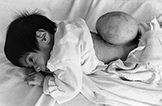Hesperian Health Guides
Chapter 22: Spina Bifida

Spina bifida (also called meningocele or myelomeningocele) is a condition that starts in the very early development of the unborn child. It happens when some of the back bones (vertebrae) do not close over the center tube of nerves (spinal cord). As a result, a soft unprotected area is left, which may bulge through the skin as a dark bag. This ‘bag of nerves’ is covered by a very thin layer (membrane) which may leak liquid from the spinal cord and brain. While the exact cause is unknown, spina bifida is hereditary, and taking folic acid during pregnancy can help lower a baby's risk of developing it. One out of every 1000 babies in the world is born with spina bifida.
Contents
Signs of spina bifida
- High risk. Without early surgery to cover the bag of nerves, it almost always gets infected and the child dies of meningitis.

- Muscle weakness and loss of feeling. The legs or feet may be paralyzed and have little or no feeling.
- Hips. One or both hips may be dislocated.
- The feet may turn down and in (club feet), or up and out.

- If the defect is relatively high up the back (L1 or above, see below), there may be muscle spasms (spasticity) in the legs and feet
- Difficulty with urine and bowel control. The child may not feel when he pees or has a stool. When he gets older he may not develop control, and will pee or shit without knowing it.
|
 very big head
big veins
The eyes may turn downward because of pressure in the head. This "setting sun sign" means danger of loss of vision and severe brain injury |
| |
PROBLEMS THAT MAY OCCUR WHEN THE CHILD IS OLDER:
 |
 |
|
 | |
|
What is the future for a child with spina bifida?

This will depend first on how serious the condition is, next on medical treatment and general care, and finally on special training and on family and community support.
The higher up the back the condition is or the more severely the spinal cord is affected, the worse the paralysis and other problems are likely to be. If the head is already very swollen, it is likely the child will be severely affected. The costs will usually be great, even for a rich family. Surgery to drain the liquid from the head is sometimes followed by infection. The operation may need to be repeated several times. In spite of the best medical attention, at least 1 of every 4 or 5 children born with severe spina bifida dies in the first months or years of life.
However, a child in which the condition occurs low down on the back usually has less paralysis. With good family and community support, many children with spina bifida go to school, learn to do many kinds of work, get married, and have children.
Often these children are late in learning basic skills for self-care (getting dressed, eating, going to the bathroom). This is partly because of the disability. But it is also because their parents often overprotect them and do everything for them. It is important for parents to help these children to do more for themselves.
What are the chances that my child with spina bifida will walk?
This depends on many factors. However, the higher up the spine the condition occurs, the more paralysis the child will probably have. The drawings below show how likely it is for the child to walk, based on the level of the condition. The shaded areas show the parts of the body affected by paralysis and loss of feeling.
| BONES OF THE “BACKBONE” (SPINE) | LEVEL OF CONDITION | PROBABLE AMOUNT OF DISABILITY |
 7
neck bones (cervical vertebrae) 12
back bones (thoracic vertebrae) 5
waist bones (limbar vertebrae) 5 joined bones at the seat (sacrum) |
| |


